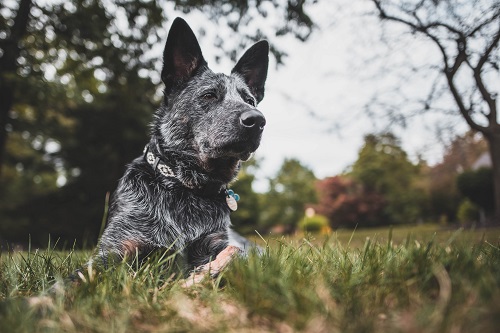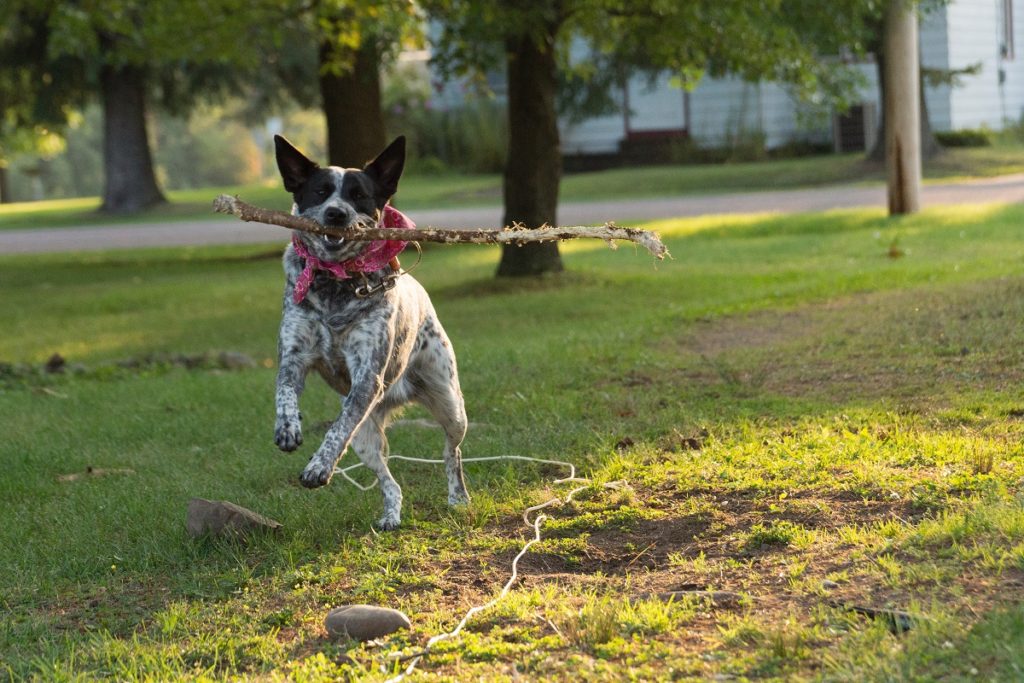Also known as the blue heeler or Queensland heeler, an Australian Cattle Dog is a visually distinct herding breed with a muscular body and boundless enthusiasm. His bright, alert expressions broadcast his innate intelligence, which can be a point of pride or a source of frustration for his pet parents, depending on how well and frequently he’s exercised. As his breed name suggests, this stocky, compact pup was originally bred to help herd cattle in the land down under but has since become a beloved household pet here in the United States.
Do Australian Cattle Dogs Shed?
One of the most notable features of this popular breed is their coat: a beautiful blend of colors, the majority can best be described as a “cookies and cream” hue of black, grey, and white. The overall effect is an aesthetically pleasing one, giving him an almost airbrush-like quality to his coat appearance. While he has a gorgeous hue, potential owners with allergies are far more interested in how well that coat stays on his body.
The Australian Cattle Dog has what is called a “double coat” – the glossy, longer fur seen on the surface of his body hides a shorter, fluffier layer of fur beneath. This undercoat is used to help him regulate his body temperature as he performs the active duties he’s been bred to do. While some shedding is inevitable, most pet parents of this breed consider it manageable with regular brushing.
What Is A “Blow Coat”?
Many furred animals – foxes, wolves, and domestic dogs alike – will change their seasonal coat for a more appropriate one when the weather shifts. Even though he will likely spend most of his time indoors as a pet, the Australian Cattle Dog is no stranger to this  genetic tradition. Twice a year, he’ll experience “blowing his coat,” which essentially means he’ll shed a great deal in a short amount of time. For a pet parent doing their best to avoid the allergies and mess that come with fur and dog dander, this can be a challenging time. Canine grooming experts recommend the following tips for getting over this hurdle without getting covered in fur:
genetic tradition. Twice a year, he’ll experience “blowing his coat,” which essentially means he’ll shed a great deal in a short amount of time. For a pet parent doing their best to avoid the allergies and mess that come with fur and dog dander, this can be a challenging time. Canine grooming experts recommend the following tips for getting over this hurdle without getting covered in fur:
- Brush your pup a minimum of twice a week. Not only is this bonding time important for the health and happiness of your dog, it also gives his owner a chance to spot snarls, mats, and tangles before they become unmanageable.
- Use a slicker-style brush during coat blows, as well as an “undercoat rake.” These tools will help pull off dead and tangled hair, which avoids the dog depositing it on furniture or carpets later through shedding.
- Always brush dogs outside, whenever possible. Even if a pet parent is diligently cleaning their brush of choice between strokes, stray hairs will fall away and settle on any indoor surface. This will, in turn, trigger allergies inside the home.
- Consider a professional groomer. Using a pro will help thoroughly and completely remove shedding hair or about-to-fall-out fur, and it also usually means a much-needed bath afterward for any stubborn hairs that are still hanging on.
- Trim or file/dremel nails at the same time. Just as scratching an itchy scalp will loosen dandruff onto the shoulders, a dog’s scratching will create and spread more allergy-causing dander throughout the home.
Alternative Grooming Methods
 The Australian Cattle Dog is world-famous for his energy and desire to be out working. That’s an excellent quality normally, but during bath and grooming time it can feel like a battle. While these dogs are notorious for “outsmarting” their human companions, they’re curious enough to distract into compliance with certain grooming tools:
The Australian Cattle Dog is world-famous for his energy and desire to be out working. That’s an excellent quality normally, but during bath and grooming time it can feel like a battle. While these dogs are notorious for “outsmarting” their human companions, they’re curious enough to distract into compliance with certain grooming tools:
- A brush/mitt device: He’ll simply feel like he’s being petted, particularly if the tool and movement are paired with soft, encouraging praise. This approach may elicit less alarm than a traditional brush, and it can be used in conjunction with a slow-enjoyment toy such as peanut butter frozen in the hollow core of a rubber ball.
- A hand-worn shower sprayer: When bathing him, a hand-worn shower sprayer that emits water jets from the palm is less likely to spook him than a traditional showerhead. Note: always be sure to check the water temperature before wetting him down for safety and comfort.
Is The Australian Cattle Dog The Right Companion For You?
While Australian Cattle Dogs do shed, it’s minimal, and kept mostly under their two-layer coat. The only exception is his biannual “blow coat,” which can also be dealt with by a professional which will help to keep the home clean. Simply commit, along with any household members, to brush and exercise him on a regular basis and the reward will be a happy, clean, low-shedding canine companion.
Sources Cited:
1) “Australian Cattle Dog.” Dogtime.com, (no publish date), https://dogtime.com/dog-breeds/australian-cattle-dog#/slide/1. Accessed October 16, 2019.
2) “About The Breed.” ACDCA (Australian Cattle Dog Club of America), (no publish date),
https://www.acdca.org/about-the-breed/. Accessed October 16, 2019.
3) “Australian Cattle Dog Guide.” Animal Planet, (no publish date), http://www.animalplanet.com/breed-selector/dog-breeds/herding/australian-cattle-dog.html. Accessed October 16, 2019.
4) “Australian Cattle Dog Breed Information and Personality Traits.” Hill’s, (no publish date),
https://www.hillspet.com/dog-care/dog-breeds/australian-cattle-dog. Accessed October 16, 2019.
5) “Australian Cattle Dog.” AKC (American Kennel Club), (no publish date), https://www.akc.org/dog-breeds/australian-cattle-dog/. Accessed October 16, 2019.




